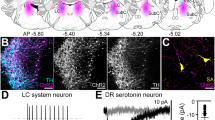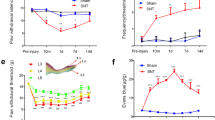Abstract
THE development of postsynaptic or postjunctional supersensitivity in peripheral, noradrenergically innervated tissue after deafferentation has been clearly demonstrated1–3. In addition there exists considerable functional and biochemical evidence that central dopaminergic receptors in the neostriatum become supersensitive after lesions of the nigro-neostriatal projection4–8. Neurochemical evidence has been provided which is consistent with the development of postjunctional supersensitivity of central noradrenoceptors after deafferentation. Thus after intraventricular injections of 6-hydroxydopamine (6-OHDA), a neurotoxin for catecholaminergic neurones, noradrenaline (NA) stimulated synthesis of cyclic AMP is potentiated9–11. Functional evidence for the development of this type of supersensitivity in central NA receptors is, however, lacking. An enhanced response to intracisternally administered α-methylnoradrenaline in 6-OHDA pretreated rats has been reported12 but such an effect could be mediated by changes in either pre- or postsynaptic mechanisms. Our experiments were designed to provide functional confirmation for the presence of postjunctional supersensitivity in central noradrenoceptors after lesions of central noradrenergic neurones. Clonidine [2-(2,6-dichlorophenylamino)-2-imidazoline] is a directly acting α-NA receptor agonist13–15 and has been shown to lower body temperature by a central α-noradrenergic mechanism. Thus intraperitoneal, intracisternal or intrahypothalamic injections of clonidine decrease body temperature16,17. It was hypothesised that if central noradrenoceptive neurones become supersensitive after destruction of noradrenergic afferents by 6-OHDA, then clonidine-induced hypothermia should be potentiated in lesioned animals.
This is a preview of subscription content, access via your institution
Access options
Subscribe to this journal
Receive 51 print issues and online access
$199.00 per year
only $3.90 per issue
Buy this article
- Purchase on Springer Link
- Instant access to full article PDF
Prices may be subject to local taxes which are calculated during checkout
Similar content being viewed by others
References
Trendelenburg, U., Pharmac. Rev., 15, 225–276 (1963).
Trendelenburg, U., Pharmac. Rev., 18, 629–640 (1966).
Fleming, W. W., McPhillips, J. J., and Westfall, D. P., Ergebn. Physiol., 68, 55–119 (1973).
Ungerstedt, U., Acta physiol. scand., Suppl., 367, 69–73 (1971).
Von Voigtlander, P. F., and Moore, K. E., Neuropharmacology, 12, 451–462 (1973).
Price, M. T. C., and Fibiger, H. C., Eur. J. Pharmac., 29, 249–252 (1974).
Mishra, R. K., Gardner, E. L., Katzman, R., and Makman, M. H., Proc. natn. Acad. Sci. U.S.A., 71, 3883–3887 (1974).
Fibiger, H. C., and Grewaal, D. S., Life Sci., 15, 57–63 (1974).
Palmer, G. C., Neuropharmacology, 11, 145–149 (1972).
Kalisker, A., Rutledge, C. O., and Perkins, J. P., Molec. Pharmac., 9, 619–629 (1973).
Huang, M., Ho, A. K. S., and Daly, J. W., Molec. Pharmac., 9, 711–717 (1973).
Breese, G. R., Moore, R. A., and Howard, J. L., J. Pharmac. exp. Thér., 180, 591–602 (1972).
Andén, N.-E., et al., Life Sci., 9, 513–523 (1970).
Corrodi, H., Fuxe, K., Ljungdahl, Å., and Ogren, S. O., Brain Res., 24, 451–470 (1970).
Haeusler, G., Naunyn-Schmiedebergs Arch. exp. Path. Pharmak., 286, 97–111 (1974).
Laverty, R., and Taylor, K. M., Br. J. Pharmac., 35, 253–264 (1969).
Tsoucaris-Kupfer, D., and Schmitt, H., Neuropharmacology, 11, 625–635 (1972).
König, J. F. R., and Klippel, R. A., The Rat Brain (Williams and Wilkins, Baltimore, Maryland, 1963).
McGeer, E. G., and McGeer, P. L., Can. J. Biochem. Physiol., 40, 1141–1151 (1962).
Ungerstedt, U., Acta physiol. scand., Suppl., 367, 1–48 (1971).
Fibiger, H. C., Phillips, A. G., and Zis, A. P., Pharmac. Biochem. Behav., 2, 87–96 (1974).
Roberts, D. C. S., Zis, A. P., and Fibiger, H. C., Brain Res. (in the press).
Reid, J. L., in Advances in Neurology, 9 (edit. by Calne, D. B., Chase, T. N., and Barbeau, A.), 73–80 (Raven, New York, 1975).
Author information
Authors and Affiliations
Rights and permissions
About this article
Cite this article
ZIS, A., FIBIGER, H. Functional evidence for postsynaptic supersensitivity of central noradrenergic receptors after denervation. Nature 256, 659–661 (1975). https://doi.org/10.1038/256659a0
Received:
Accepted:
Issue Date:
DOI: https://doi.org/10.1038/256659a0
This article is cited by
-
Clonidine and a ?-agonists induce hyperthermia in rats at high ambient temperature
Journal of Neural Transmission (1985)
-
Supersensitivity to the anticonvulsant and proconvulsant activity of clonidine following noradrenaline depletion induced by 6-hydroxydopamine
Psychopharmacology (1985)
-
The bisphosphonates HEBP and AHPrBP but not AHBP inhibit mineral mobilization and lysosomal enzyme release from mouse calvarial bones in tissue culture
Experientia (1984)
-
Clonidine-induced sedation in rats: Evidence for mediation by postsynaptic? 2-adrenoreceptors
Journal of Neural Transmission (1982)
-
Changes in brain catecholamine turnover and receptor sensitivity induced by social deprivation in rats
Psychopharmacology (1978)
Comments
By submitting a comment you agree to abide by our Terms and Community Guidelines. If you find something abusive or that does not comply with our terms or guidelines please flag it as inappropriate.



